
Sea Monster or Shark?
An Analysis of a Supposed Plesiosaur Carcass Netted in 1977
Copyright © 1997-1998 by
Glen J. Kuban
[This article is being mirrored from http://paleo.cc/paluxy/plesios.htm.]
![]()

Sea Monster or Shark?
An Analysis of a Supposed Plesiosaur Carcass Netted in 1977
Copyright © 1997-1998 by
Glen J. Kuban
[This article is being mirrored from http://paleo.cc/paluxy/plesios.htm.]
![]()
A decayed carcass accidentally netted by a Japanese trawler
near New Zealand in 1977 has often been claimed by
creationists and others to be a likely plesiosaur or
prehistoric "sea-monster." Plesiosaurs were a group of
long-necked, predatory marine reptiles with four paddle-like
limbs, thought to have gone extinct with the dinosaurs
about 65 million years ago. However, several lines
of evidence, including lab results from tissue samples taken
from the carcass before it was discarded, strongly point to
the specimen being a shark, and most likely a basking shark.
This should not be surprising, since basking sharks are known
to decompose into "pseudoplesiosaur" forms, and their carcasses
have been mistaken for "sea-monsters" many times in the past.
Unfortunately, the results of scientific studies on the carcass
data received less media attention than the early sensational
reports, allowing widespread misconceptions about this case
to continue circulating. Therefore, a thorough review
of its history and the pertinent evidence is warranted.
On April 25, 1977, a fishing vessel named the Zuiyo-maru of the Taiyo Fishery Company Ltd. was trawling for mackerel about 30 miles east of Christchurch, New Zealand, when a large animal carcass became entangled in its nets at a depth of about 300 meters (almost 1000 feet). As the massive creature, weighing about 4000 pounds, was drawn toward the ship and then hoisted above the deck, assistant production manager Michihiko Yano announced to the captain (Akira Tanaka), "It's a rotten whale!" However, as Yano got a better look at the creature, he became less sure. About 17 other crew members also saw the carcass, some of whom speculated that it might be a giant turtle with the shell peeled off. However, no one on board could say for sure what it was (Aldrich 1977; Koster 1977).
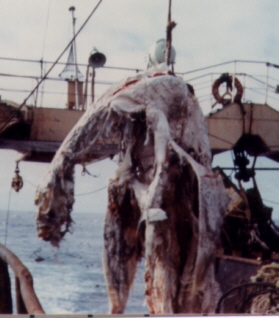
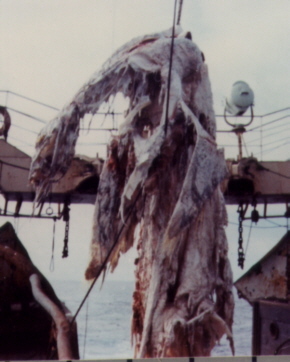
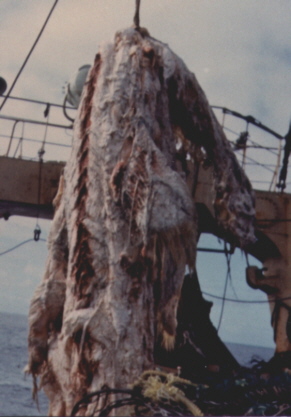
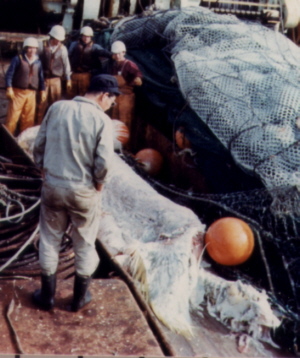
Figure 1. Four of the photographs taken by Michihiko Yano aboard the Zuiyo-maru on April 25, 1977. A, B. Two front views of the carcass. These were the photos that inspired many to view the carcass as plesiosaur like. C. The only clear photograph of the back of the carcass, showing an apparent dorsal fin and myocommata along the spine (see Figure 5). D. The carcass on the deck, with the anterior end toward the right. A fifth photograph (not shown) is an almost identical view of the carcass on the deck, and provides no additional information.
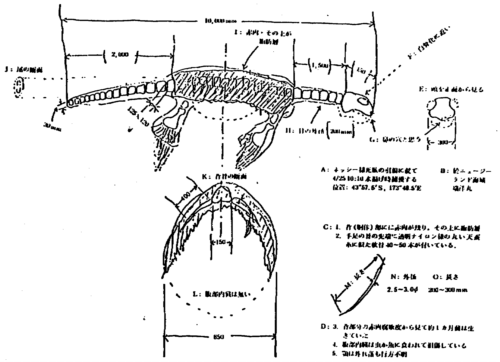
Figure 2.
Figure 2. Sketch of the Zuyiyo-maru carcass, made my Michihiko Yano two months
after carcass was examined and thrown overboard. Sketch and translations appeared in
the Collected Papers of the Carcass of an Unidentified Animal Trawled Off New Zealand
by the Zuiyo-maru, 1978. Major body segment measurements difficult to see in the
drawing: Overall length: 10000 mm, head length: 450 mm, neck length: 1,500 mm.
Translations: A. Capture of a Nessie-like carcass. Trawled on April 25, 10:00 am at 43 deg. 57.5 min. S, 173 deg. 48.5 min. E [sic]. B. At the sea off New Zealand; Zuiyo-maru. C. 1. Red muscles remaining on the back of the trunk, overlaid by fat tissues. 2. There are 40-50 pieces of transparent, nylon-like cartilages roundish in cross section, around the tips and limbs. D. 3. Judging from the state of putrefaction, the animal may have been alive until about one month before acquisition. 4. Internal organs in the abdomen are damaged, eaten by worms or fish. 5. The lower jaw has been lost. E. Front view of the head (300 mm). F. Well skeletonized. G. Probably nostrils [sic]. H. Diameter of the [neck vertebral bone (200 mm). I. Red muscles; fat layers on them. J. Cross section of the tail. K. Cross section of the back bone (150 mm). L. No internal organs in the abdomen. M. Length. N. Diameter [of horny fibers?]. O. Length [of fibers] (200- 300 mm).
When Yano returned to Japan on a different boat on June 10th, 1977, he promptly had his photos developed in the fishery's darkroom. Company executives were fascinated with the photos, some of which did appear to show an unusual animal with a long neck and small head. Local scientists were asked to look over the photos, and remarked that they had never seen anything like it (Koster 1977). Some speculated that it might be some kind of prehistoric creature such as a plesiosaur.
On July 20, 1977, as excitement and speculation about the find began to spread, officials from the fish company held a press conference to publicly announce their mysterious discovery. Although scientific analysis of the tissue samples and other data had not yet been completed, company representatives played up the sea-monster angle. The same day several Japanese newspapers published sensational front-page accounts of the find, soon followed by many other radio and television stories throughout Japan (Sasaki 1978). Although some Japanese scientists remained cautious, others encouraged the plesiosaur idea. Professor Yoshinori Imaizumi, director of animal research at Tokyo National Science Museum, was quoted in the Asahi Shimbun newspaper as saying, "It's not a fish, whale, or any other mammal... It's a reptile, and the sketch looks very like a plesiosaur. This is a precious and important discover for human beings. It seems to show these animals are not extinct after all." (Koster 1977). Tokio Shikama of the Yokohama National University also supported the monster theme, stating, "It has to be a plesiosaurus. These creatures must still roam the seas off New Zealand feeding on fish." (Wire Service Reports, 7/25/77, reported in Aldrich 1977).
Meanwhile, American and European scientists interviewed about carcass mystery generally downplayed the sea-monster theory, as reported by a number of newspapers and wire services (Denver Post, 7/21/77; Washington Post, 7/22/77; Boston Globe, 7/22/77); New York Times, 7-24-77; UPI, 7/24/77; New Scientist 7-28-77). Paleontologist Bob Schaeffer at the American Museum in New York noted that every ten years or so a carcass is claimed to be a "dinosaur" but always turns out to be a basking shark or adolescent whale. Alwyne Wheeler of the British Museum of Natural History, agreed that the body was probably a shark. Explaining that sharks tend to decompose in an unusual manner (addressed further below), Wheeler added, "Greater experts than the Japanese fishermen have been foiled by the similarity of shark remains to a plesiosaur" Other western scientists offered their own interpretations; Zoologist Alan Fraser-Brunner, aquarium curator at the Edinburgh Zoo in Scotland, suggested the body was a dead sea lion (Koster 1977), despite the creature's immense size. Carl Hubbs, of the Scripps Institute of Oceanography in Jolla, California, felt it was "probably a small whale...so rotten that most of the flesh was sloughed off" George Zug, curator of reptiles and amphibians at the Smithsonian Institute, proposed that the creature was a decayed leatherback turtle (Aldrich 1977).
The divergence among early scientific opinions in this case might be partly due to the fact that many biologists and zoologists are used to working with complete, fresh specimens rather than badly decomposed carcasses (or worse, photos of such), in which both external and internal organs can be quite different from their appearance in living animals (Obata and Tomoda, p 46).
On July 25 1977, Taiyo Fish Company issued a preliminary report on biochemical tests (using ion-exchange chromatography) on the tissue samples. The report stated that the horny fiber sampled from the carcass was "similar in nature to the fin rays a group of living animals." The "living animals" referred to were sharks; however, the report failed to state this plainly, leading to further confusion by the Japanese media (Sasaki 1978) and the continued spread of monster mania. Toy manufacturers began gearing up to make wind-up models of the beast, while the company which made Yano's borrowed camera developed a whole advertising campaign around his "sea-monster" photos. Dozens of fishing vessels from Japan, Russia, and Korea were reportedly streaming toward New Zealand in hopes of resnagging the hastily discarded creature. Bubbling with excitement, one Japanese citizen confided that he thought sea-monsters were imaginary creatures but "danced when I read in the newspaper that it was still alive!" (Koster 1977). The Japanese government even issued a new postage stamp (Figure 3) featuring a picture of a plesiosaur. Not since Godzilla had a monster so overtaken Japan.
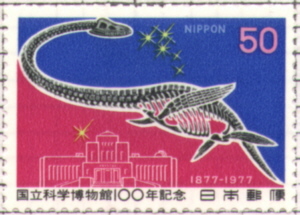 Figure 3.
Commemorative Japanese stamp issued Nov. 2, 1977 in the
wake of the sea-serpent hysteria, showing a long-necked
plesiosaur and the National Science Museum.
Figure 3.
Commemorative Japanese stamp issued Nov. 2, 1977 in the
wake of the sea-serpent hysteria, showing a long-necked
plesiosaur and the National Science Museum.
The carcass controversy continued to make appearances in the popular press in America, but with less sensationalism. On July 26, 1977 The New York Times reported that professor Fujio Yasuda, who initially promoted the carcass resembled a plesiosaur, acknowledged that initial chromatography tests showed a profile of amino acids closely resemembling a control sample from a blue shark. An August 1, 1977 Newsweek article briefly discussed the "South Pacific Monster" without taking sides. A few months later a more detailed article by John Koster (1977) appeared in Oceans magazine. This account evidently the basis for many subsequent reports, many of which embellished or oversimplified various aspects of the story. Koster mentioned the preliminary tissue results and comments by western scientists supporting the shark interpretation, but also quoted Yano and others suggesting that the issue was not yet settled. Koster himself suggested that the small size of the creature's head, well-defined spinal column, and the lack of dorsal fin, did not fit the shark identification.
Soon news of the controversial carcass also came to the attention of some strict creationists, who suggested that the "likely plesiosaur" supported their young-earth position (Swanson 1978; Taylor 1984; Peterson 1988). After all, they seemed to imply, if a creature supposedly extinct for millions of years can turn up in a fishing net, how can we trust anything geologists tell us?
However, even if a modern plesiosaur were confirmed, it would not threaten the concept of evolution. After all, many other modern animal groups existed during the Mesozoic Era, such as crocodiles, lizards, snakes, and various fish. Most of these groups are well represented in the fossil record leading to the present time, but some creatures, such as the Coelacanth and Tautara were once thought to have been extinct for tens of millions of years, only to be later found alive and little changed in modern times. These cases emphasize the incompleteness of the fossil record and the remarkable stasis of some animal groups, but are not grounds for upheavals in evolutionary thought. Nevertheless, the discovery of a modern plesiosaur would certainly be a stupendous scientific find in its own right, confirming that long-necked "sea serpents" were not just long-extinct creatures or the stuff of sailor's myths, but real "living fossils." Unfortunately, a more thorough examination of the evidence would convincingly refute the plesiosaur interpretation.
As mentioned, some scientists believed from the start that the carcass in question was probably a shark, based on their knowledge of basking shark decay, and similar "sea serpent" carcass incidents of the past. The basking shark, Cetorhinus maximus, is the second largest fish in the sea (surpassed only by the whale shark). It can grow to more than 30 feet in length, and specimens over 40 feet have been reported (Soule 1981; Freedman 1985; Dingerkus 1985). However, this gentle giant is harmless to humans. It feeds by filtering plankton (mostly tiny crustaceans) through its large gill rakers as it swims lazily just under the water's surface with huge mouth agape. When the basking shark decays, the jaws and loosely attached gill arches often fall away first, leaving the appearance of a long neck and small head (see Figure 4). All or part of the tail (especially the lower half which lacks vertebral support) and/or the dorsal fin may also slough away before the better supported pectoral and pelvic fins, creating a form that superficially resembles a plesiosaur (Huevelmans 1968; Burton & Burton 1969; Cohen 1982; Bright 1989 Ellis 1989). Some have called such remains "pseudoplesiosaurs" (Cohen 1982), although one might also dub them "plesiosharks"
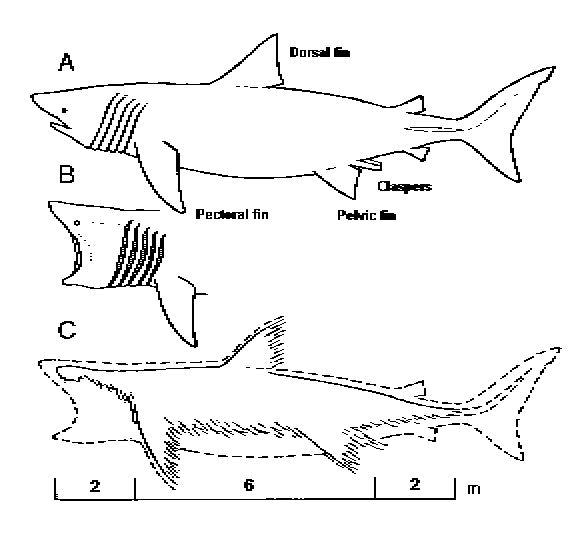
Figure 4. Basking shark and "pseudoplesiosaur"
A. Basking shark in closed-mouth profile.
B. Basking shark while feeding.
C. Decomposed basking shark presenting a
plesiosaur-like shape. Scale bar shows that a
10 meter basking shark carcass with tail
lost would have essentially the same body
proportions as those indicated in the Zuiyo carcass (Figure 2). The
carcass head and neck combined were measured at 1.95 m long
and the tail 2.0 m, making the unmeasured torso (mid section)
6.05 m by calculation.
As recounted by renowned cryptozoologist Bernard Heuvelmans (1968), over a dozen supposed "sea serpent" carcasses of years past were later shown to be definite or probable shark carcasses--in most cases basking sharks. These include (but are not limited to), the famous "Stronsa Beast" of Orkney Islands, England (1808), the Raritan Bay carcass of New Jersey (1822), the Henry Island, British Columbia carcass (1934) and the Querqueville monster, France, also in 1934. These were followed by the Hendaye carcass in France (1951), the New South Wales carcass, (1959), and two more cases in 1961 (Vendee, France, and Northumberland, England). In 1970 another supposed "monster" washed up at Scituate, Massachusetts. This 30 foot beast was said to look remarkably like a plesiosaur; however, it also turned out to be a decayed basking shark (Cohen 1982; Bright 1989). In 1996 yet another supposed sea serpent was stranded on Block Island, RI. It too has been evaluated as a probable basking shark, and was nicknamed the "Block Ness Monster" (Roesch 1996).
Interestingly, basking sharks seem to have a propensity to mimic sea serpents while alive as well as dead. Often they feed in groups at or near the surface (hence their name), sometimes lining up two or more in a row. When they do this, the dorsal and tail fins protruding from the water can be, and sometimes have been, mistaken for multiple "humps" and head of a long-bodied sea-monster (Sweeney 1972; Bright 1989; Ellis 1989; Perrine 1995).
By the time the Oceans article was going to press, scientists in Japan had already formed a research team to study the Zuiyo-maru case more closely. Copies of the carcass photographs had reached scientists at the Tokyo University of Fisheries, including its president Dr. Tadayoshi Sasaki, who proposed a meeting of scientists to study the available data. Initial meetings were on September 1 and September 19, 1977, attended by over a dozen scientists, including specialists in biochemistry, ichthyology, paleontology, comparative anatomy, and other fields. The workers agreed to avoid publicizing their individual conclusions until the study was completed (Sasaki 1978).
In July of 1978, a collection of nine papers presenting the team's findings were published in a report by the Societe Franco-Japonaise d'Oceanographie. Despite some disagreements over specific items of evidence, and the view of some workers that the identification was still uncertain, the majority opinion was that the carcass was a badly decomposed shark, and most likely a basking shark (Sasaki 1978). This conclusion was strongly supported by several lines of evidence, including studies on the microscopic appearance, chemical composition and physical properties of the tissue samples, as well as a number of anatomical considerations, elucidated below.
-- The horny fibers sampled from the carcass were rigid, needle-like structures that tapered toward both ends and had a translucent light-brown color (Kimura, Fujii, and others 1978). Such features are characteristic of ceratotrichia, the cartilaginous fibers of shark fin rays. Abe (1978) found that the carcass fibers and known ceratotrichia from a basking shark "resembled each other remarkably."
-- Gross amino acid analysis of the carcass samples gave results that closely matched elastoidin from a known basking shark. Elastoidin is a collagenous protein known only from sharks and rays (not reptiles or even other fish). The match was especially impressive when known basking shark elastoidin was treated with an antiseptic sodium hypochlorite (NaClO) solution, as were the Zuiyo-maru samples (Obata and Tomoda 1978, p 52; Omura, Mochizuki, and Kamiya 1978, p 58). The correspondence was virtually identical on all 20 amino acids tested (Table 1). In discussing this "striking similarity," Kimura, Fujii, and others (1978, p 72) noted that a statistical test called the "difference index (DI)" gave the extremely low value of .95 indicating a tight match. They also noted that the high tryosine content (43 and 41 residues for the samples) is especially characteristic of shark elastoidin as compared with other collagens, which typically have 5 or less residues. ceratotrichia.
1977 Carcass Known Sample of basking Amino Acid Sample Shark Elastoidin 4-Hydroxyproline 45 45 Aspartic/acid 54 55 Threonine 25 25 Serine 39 40 Glutamic acid 80 80 Proline 130 125 Glycine 291 290 Alanine 109 110 Cystine (1/2) 7 6 Valine 25 24 Methionine 10 10 Isoleucine 20 20 Leucine 19 19 Tyrosine 43 41 Phenylalanine 12 12 Hydroxylysine 5 6 Lysine 25 26 Histidine 11 13 Arginine 51 53 (Amide-N) (57) (62)
Table 1. Results of Gross Amino Acid Analysis on the Horny Fiber from the 1977 Zuiyo-maru Carcass and Known Elastoidin of a basking Shark (residues/1000 residues). Composition was determined by JLC-3BC liquid chromatography (JEOL Co. Ltd.). Both samples had been treated with NaClO. (Kimura, Fujii, and others 1978).
-- The horny fibers from the fin showed a distinctive shrinking to about 1/3 the original size when heated in water to 63 degrees C, and gradually reelongated upon cooling. This unique hydrothermal behavior is characteristic of elastoidin (Kimura, Fujii, and others 1978, p 68).
-- Electron micrographs of the tissue showed numerous parallel protofibrils, along with a particular banding pattern that is characteristic of shark elastoidin. Micrographs also revealed a major periodic striation pattern of 450-500 angstroms, which is shorter than typical collagens, but which was previously observed in basking shark elastoidin (Kimura, Fujii, and others 1978).
-- Earlier gas chromatography analysis on the horny fibers gave results consistent with shark tissue (Sasaki 1978)
Kimura, Fujii, and others (1978) concluded that the composite tissue sample studies indicated that the horny fiber was essentially identical to known basking shark elastoidin in both its morphology and amino acid composition. They remarked, "If the horny fiber was pulled out from an animal belonging to other classes except Chondrichthyes [sharks and relatives], it should be significantly different...These results strongly suggest that this unidentified creature is a basking shark or closely related species (Kimura, Fujii, and others 1978, p 73).
-- The carcass sketch showed six neck vertebrae, viewed as "seven or so" by Obata and Tomoda (1978), which is reasonably consistent with Yano's measurements of neck length (150 cm) and individual vertebra diameter (20 cm). It is also consistent with sharks. However, 6 to 7 cervical vertebrae is not consistent with plesiosaurs and other marine reptiles. Even the pliosaurs, also known as "short-necked" plesiosaurs, have at least 13 neck vertebrae; the "long necked" plesiosaurs have far more. (Obata and Tomoda, 1978, p 46).
-- The head of the creature was reported to be turtle-like (Obata and Tomoda, 1978, p 48). This is consistent with the known cranial remains of a basking shark, which have been specifically described as resembling a turtle head (Omura, Mochizuki, and Kamiya 1978, p 59). In contrast, plesiosaurs had more triangular shaped heads that were not particularly turtle-like (Hasegawa and Uyeno 1978, p 64).
-- Photographs and witnesses confirm the presence of fin rays, which are possessed by most fish, including sharks. In contrast, plesiosaurs had bony phalanges as flipper supports, which were not seen in the carcass (Obata and Tomoda 1978, p 51). The limb bones shown in Yano's drawing were evidently based on presumption or pro-plesiosaur bias rather than observation (Omura and others 1978, p 56; Obata and Tomoda 1978, p 49).
-- One of the photos (Figure 1c) shows an apparent dorsal fin,
as illustrated in Figures 5). Dorsal fins are possessed by
most fish including sharks, but are thought to have been
lacking in plesiosaurs.
-- The V-shaped along the vertebral column (Figure 1c and 5), and near the pectoral girdle (Figure 1a) were identified as myocommata by Omura, Mochizuki, and Kamiya 1978, p 56-57). Myocommata are composed of strong connective tissues between myomeres, and are found in sharks but not reptiles.
-- The ribs were measured as 40 cm (about 16 inches) long, which is far too short for plesiosaurs or other marine vertebrates except sharks (Hasegawa and Uyeno, p 65). Ironically, some have asked whether the ribs might be too long for a shark, which typically have very small ribs. But this was an exceptionally large specimen, and was probably even larger before decomposition. Also, it is not certain that Yano accurately identified or measured the ribs, which do not appear in the photos. Perhaps he mistakenly measured remnant gill arches, myocommata, or muscle furrows, under the assumption that they corresponded to ribs.
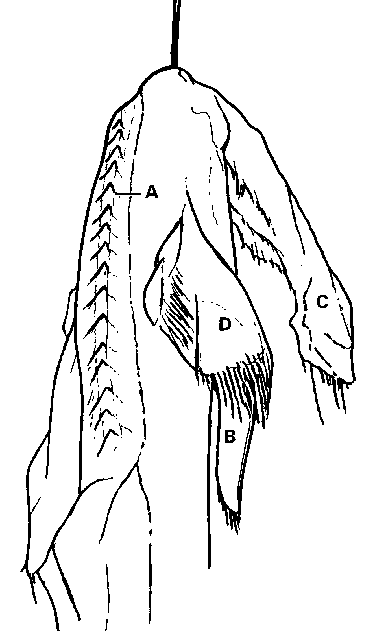
Figure 5. Interpretive drawing of the photograph in Figure 1c. A. Myocommata. B. Right fore limb. C. Cranuim D. Dorsal fin. Compare to Figure 1c.
-- As seen in the photos, the anterior fins appears to be articulated at a right angle to the shoulder, consistent with sharks but not plesiosaurs (Obata and Tomoda 1978, p 46); Hasegawa and Uyeno 1978, p 65). The pectoral girdle is visible between the front fins in Figures 1a and 1b, and appears broken but is shark-like in shape (Compagno 1997; Phelps 1997; Roesch 1997).
-- If the carcass were a plesiosaur, the body would be unlikely to bend in the posture shown in some of the photographs, since the breast bone would be large and flat. Likewise, the ventral bones of plesiosaurs, which should have remained if the anterior fins were preserved, are not seen in the carcass (Hasegawa and Uyeno 1978, p 64).
-- In plesiosaurs, bones of all limbs were situated at the ventral (lower) portion of the body; therefore, if the creature were a decayed plesiosaur, it is likely the limbs would have already been detached from the body (Hasegawa and Uyeno 1978, p 63).
-- At the existing degree of decomposition, a plesiosaur would probably have retained its upper jaws and teeth (Hasegawa and Uyeno 1978, p 63), but no teeth were reported in the specimen carcass (Obata and Tomoda 1978, p 48). A basking shark, however, is known to easily loose both jaws, and even if it retained the upper jaw, its extremely tiny teeth could be more easily overlooked.
-- The carcass length was reported as 10 meters (33 feet). Basking sharks commonly grow to 30 feet more (Dingerkus 1985; Freedman 1985), and specimens over 40 feet long have been reported (Heuvelmans 1968; Herald 1975; Soule 1981; Steel 1985). Some authors indicate they may even grow to 50 or more feet (Springer and Gold 1989; Perrine 1995; Allen 1996) The carcass size would also be compatible with a small plesiosaur, but the body proportions are not (explained below).
-- Although some of Yano's measurements seem surprisingly round (for example, 2000 mm for the tail and 10000 mm total length), if we assume they are reasonably accurate, then the body proportions (approximately 2:6:2 for the head+neck:torso:tail) are incompatible with any known plesiosaur fossils (Obata and Tomoda 1978, p 52). In many plesiosaurs the neck is by the longest section, and in no case is the torso (between the pelvic and pectoral fins) much longer than the head and neck, as it is in the carcass. The carcass could have lost some length through tail loss (discussed below), but the neck to torso ratio would still be incompatible with plesiosaurs.
-- The carcass body proportions are largely compatible with a large basking shark carcass, especially one that lost its tail (compare Figures 5 and 2). Loss of the tail would be likely, since the wide tail would tend to snap at the narrow juncture during decay and buffeting in the water. This would explain the blunt rather than tapering tail end in Yano's sketch. The rostrum (nose tip) may also have been lost, but would not appreciably affect the overall body length or proportions. Adding a tail would mean the shark was closer to 12.5 meters (41 feet) in life, which would be exceptionally large, but still within the generally accepted size range of basking sharks. After all, this poor basker may have died of old age.
The combined anatomical evidence thus strongly indicates a shark and and effectively rules out a plesiosaur. Obata and Tomoda (1978, p 52) conclude, "there are no known fossil reptilian species that agree with the animal under consideration." Likewise, Hasegawa and Uyeno (1978, p 64) write, "From the osteological point of view, we conclude that this creature does not belong to the plesiosaurian reptiles."
-- Japanese shark-fin processors, who are thoroughly familiar with shark carcasses, identified the animal in Yano's photographs as a shark (Abe 1978).
-- In September 1977, a positively identified basking shark carcass was stranded at Nemuro, Hokkaido, and showed a remarkable resemblance to the Zuiyo-maru carcass found only five months earlier. Describing the September stranding Omura, Mochizuki, and Kamiya (1978, p 59-60) wrote, "The jaws and gill-arches were missing, and the cranium had a somewhat turtle-like appearance...the pectoral and pelvic fins were damaged at their apexes but still remained. The results of this experiment undertaken by nature support the view that the Zuiyo-maru carcass was a giant shark that has lost its jaws and gill arches."
Summarizing their findings, Hasegawa and Uyeno (1978) state, "Based on available evidence, we are convinced that this New Zealand creature is not the "New Nessie," that much of the world was hoping for, but more than likely a carcass belonging to a large size shark."
Despite all the evidence pointing to a shark, some purported inconsistencies with the shark identification were raised in the 1978 report and elsewhere, and should be reviewed as well.
-- The carcass reportedly smelled like a dead marine mammal, and lacked an ammonia smell characteristic of shark carcasses (Hasegawa and Uyeno 1978, p 65). However, it is not known whether all sharks give off the ammonia smell while decaying, or for how long. The same authors noted that the lack of ammonia smell could be due to the extent of skin loss and decomposition, so that the ammonia from the carcass was washed out by the sea (Hasegawa and Uyeno 1978, p 65). Also, even when alive, basking sharks are known to emit a unique, highly offensive odor of their own (Steel 1985; Ellis 1989) which could have overpowered any ammonia smell.
-- A white, sticky, fat-like substance covered much of the carcass (Obata and Tomoda 1978, p 49). Although Niermann (1994, p 103) and a few others (Hasegawa and Uyeno 1978) considered this the strongest argument against the shark theory, it is actually consistent with it. Basking sharks have large deposits of fat in the white muscle and liver. According to some authorities they increase fat reserves during the summer for winter use (Steel 1985; Sims 1997). The animal in question likely died in late March or early April, which is late summer in New Zealand. Moreover, one of the Japanese workers (Seta 1978) explained the phenomena of adipocere formation in decaying carcasses of sharks and other animals, whereby new fatty material can be generated during the decay process. Seta indicated that the whitish, putrid-smelling viscous substance on the carcass was consistent with adipocere formation. Also, some of the whitish, stringy material probably consisted of ligaments and connective tissue (Omura, Mochizuki, and Kamiya 1978, p 56). Such fibrous tissues on other basking shark carcasses evidently prompted some reports of "sea monster" corposes with white manes of hair (Heuvelmans 1968; Sweeney 1972).
-- The photographs reportedly show the presence of reddish muscle under the white material, which Obata and Tomoda (1978, p49) suggest is compatible with a tetrapod (four legged animal). However, the presence of reddish muscle is also compatible with a shark. Sharks like other fish have both white and red muscle (Fowler 1997; King 1997; Sims 1997). The former predominates, but fish that swim slowly and steadily like basking sharks generally have more red muscle than other sharks (Tullis 1997). Some of the reddish color also could be due to blood residue.
-- The concerns of some authors about the "small head" or "long neck" (Koster 1977, Yasuda and Taki 1978) are eliminated once one understands the process of decay in basking sharks. Summarizing this process, Omura, Mochizuki, and Kamiya (1978, p 59) state, "...a disproportionately small skull and long, slender neck can be accounted for by the loss of the jaws and gill-arches in the course of decomposition of the carcass."
-- Obata and Tomoda (1978, p 48) also suggest that unlike sharks, in which the nares (nostrils) are situated in the lower surface of the skull, the carcass had holes that Yano called "probably nares" at the front end of the cranium. However, the rostrum or anterior most structure may have been missing, so that the nares could have been on the lower side and also the "front" of what remained of the skull, eliminating any inconsistency. Alternatively, what Yano thought to be nares could have been any of several other fenestral openings that exist in shark skulls, or new ones created during decay.
-- Some witnesses denied the presence of a dorsal fin (Obata and Tomoda 1978). However, even if a dorsal fin were absent, it could have been rotted away. Second, as mentioned, one photo does show an apparent dorsal fin (see Figures 1c and 5) which was evidently overlooked by Yano and others. Omura, Mochizuki, and Kamiya (1978, p 56) state, "...by a close examination of the photograph we can clearly distinguish the base of a dorsal fin, though it had slipped from the mid-dorsal line." They note that this somewhat dislocated dorsal fin evidently had partially overlapped the right pectoral fin, which may account for Yano's description of the latter as having two sets of horny fibers.
-- Obata and Tomoda (1978, p 49) suggest that the "long, cylindrical ribs" in the carcass are not found in selachians." However, as explained earlier, it is not certain that Yano accurately identified or measured the ribs. Even if he did, the rib length (40 cm) is more compatible with a large shark than a plesiosaur. If the creature were a plesiosaur, it would have had to be a short necked plesiosaur, whose ribs would be at least triple the reported length (John Martin 1997).
-- The head was said to be quite hard, whereas sharks contain no bones, only cartilaginous skeletons. However, cartilage in shark skulls can be quite hard and dense, and basking sharks have especially well-calcified skeletons (Steel 1985). Also, as a shark ages, its skull becomes harder and denser. The size of the carcass clearly indicates an older specimen.
-- The pelvic (hind) fins were said by some of the crewmen to be similar in size to the pectoral fins, as in a plesiosaur (Obata and Tomoda 1978, p 49). However, this cannot be confirmed, since no measurements or photos were taken of the pelvic fins. Yano and others may have mistaken the large, draping and dislocated dorsal fin for one of the other fins (Hasegawa and Uyeno, (1978, p 62). Or, the combination of the pelvic fins and rear genital claspers created the illusion of a sizable rear fin (Hasegawa and Uyeno 1978, p 63). This might explain Yano's comment that the rear fins had an unusual appearance like that of a seal (Koster 1977). It is also possible that the pectoral fins decayed somewhat more than the pelvic fins, reducing their size disparity. Yano himself acknowledged that to the best of this recollection the front fins were somewhat larger than the rear (Koster 1977). His sketch suggests otherwise, but it is known to contain a number of other inaccuracies, such as bones in the fins that were not really seen. Noting such problems, Yasuda and Taki (1978) considered the sketch inherently unreliable, and Obata and Tomoda (1978) suggest it was influenced by bias. Indeed, by the time Yano drew the sketch (two months after the netting) the plesiosaur idea had become popular, and Yano had become something of a celebrity over it (Koster 1977).
-- Some readers may be wondering if the location of the find was a problem for the basking shark identification (as hinted at by Yasuda and Taki 1978). However, basking sharks are known from many temperate parts of the world, including the waters around New Zealand (Burton and Burton 1969; Springer and Gold 1989; Francis 1997). The carcass was thought to have died in an area somewhat south of the capture site, well within the known range of basking sharks (Nasu 1978).
Overall 1978 reports provided strong evidence favoring the shark identification, and no substantial objections to it. Even workers authors such as Obata and Tomoda, who initially supported the plesiosaur idea and emphasized potential problems for the shark interpretation, acknowledged that most evidence pointed to a shark and ruled out a plesiosaur. They stated, stating, "There are no known fossil reptilian species which agree with the animal in question" (Obata and Tomoda 1978). Most of the other 1978 report authors more plainly stated that the evidence strongly indicated a basking shark or closely related species (Abe, 1978; Hasegawa and Uyeno 1978; Omura, Mochizuki, and Kamiya 1978; Kimura et al 1978).
Unfortunately, the 1978 reports received less public attention than the original "sea-monster" stories. Most popular media seemed content to simply let the matter drop rather than helping to set the matter straight with follow-up articles. Likewise, several monster/mystery writers continued to depict the case as largely unresolved, including Welfare and Fairley (1980), Soule (1981), and Bord & Bord (1989). However, some good summaries of the 1978 research were provided by Cohen (1982), Bright (1989), LeBlond (1992), and Ellis (1994) who put aside any hopes that the beast was a plesiosaur, and properly explained that the specimen evidently represented one of several basking shark carcasses mistaken as a sea-monster.
Unfortunately, many creationists continued to promote the plesiosaur interpretation long after 1978, including Ian Taylor (1984, 1987, 1989, 1996), Paul Taylor (1984, 1987), Baugh (1987), Peterson (1988), Baker (1988), Dye (1989), Bartz (1990, 1992), Buckna (1993), and Morris (1993, 1997). Most seemed unaware of the 1978 resarch and reports. Some flatly called the beast a plesiosaur (Scoggan 1996; Hovind 1996), or "sea-monster" (Doolan 1994), or "dinosaur" (Hovind 1996) (plesiosaurs are not dinosaurs). Even more perplexing were the comments of creationists who did seem aware of the 1878 work and tissue tests, and yet suggested they supported the plesiosaur identification. Among the most troubling statements are the following:
"From photographs, sketches with careful measurements, and flipper samples for tissue analysis, it had every appearance of being a plesiosaur or sea-dwelling dinosaur..." (Ian Taylor 1984, 1978)
"Photographs, measurements, and tissue samples all show that it was probably a plesiosaur." (Paul Taylor 1987).
"Photographs, tissue examinations, and measurements were made by the Japanese scientists. Their findings point to a descendant of the plesiosaur" (Baker 1988).
Some even complained that the press was suppressing the plesiosaur story (Bartz 1992; Scoggan 1996; Taylor 1996), despite its coverage in dozens of popular books and articles, and the fact that it was often presented in a way more favorable to the plesiosaur interpretation than the evidence warranted.
Recently two creationists have written more accurate but still incomplete summaries of the case. Niermann (1994) noted that the 1978 studies pointed to a shark, and that basking sharks tend to decay into plesiosaur-like shapes. Unfortunately, he tucked these comments into footnotes, while the body of the text encouraged the plesiosaur interpretation. Todd Wood (1997) acknowledged that the evidence strongly supports the basking shark conclusion, but listed several alleged inconsistencies with the shark identification--none of which stand up to close scrutiny.
As expected, the New Zealand monster story has also drifted onto the Internet, often in mangled form. Creationists Kent Hovind (1996) , Walter Brown (1996) , Bernard Northrup (1997) , Paul Smithson (1996), and Don Patton (1995) all encourage the plesiosaur interpretation. Brown matter-of-factly calls the creature a plesiosaur, which he incorrectly calls a sea-going "dinosaur." He also notes that the carcass had vertebrae, asserting these are "something not present in many fish, including sharks." (Of course fish, including sharks, do have vertebrae). In contrast, Strange Magazine's "globsters" web site provides fairly accurate summaries of the Zuiyo-maru carcass and several other carcass strandings, as does Roesch (1997a).
Before closing, a word of friendly advice is offered to anyone who might come upon an unidentified sea creature in the future. Although it is fortunate that Yano thought to take tissue samples, had he or others on board saved the animal's head or even a vertebra (which could have been sealed in a bucket or other container to avoid fish contamination), much time, effort, and speculation could have been avoided. In most cases even a single skeletal element would allow scientists to readily identify an unknown creature. It also would have been wise to take more photos, including close-ups of the head and other body parts, rather than just a few distant shots. That these things were not done suggests that the crew did not even suspect the creature could be a plesiosaur until others later suggested this. After all, even among a group of fishermen someone should have realized that a prehistoric "sea-monster" would be worth incalculably more both financially and scientifically than a load of mackerel. As it turned out, there is little doubt that they actually caught a decomposed shark.
Nevertheless, it is possible that unknown creatures do still lurk in the ocean depths. As evidence, only five months before the Zuiyo-maru incident a naval research vessel near Hawaii accidentally snagged a bizarre, 4.5 meter (15 foot) long shark in its parachute-like sea-anchor. The curious fish had an unusually large head and wide, bowl-shaped jaws--features which soon earned it the nickname "megamouth." Its jaws were filled with hundreds of tiny teeth, and opened at the top rather than at the bottom as in most other sharks. Even stranger, the inside of the mouth seemed to glow with a silvery light. Apparently megamouth uses its reflective mouth tissue to attract tiny crustaceans while feeding in deep water, where little sunlight penetrates. Eventually the odd selachian was given the scientific name Megachasma pelagios, and was determined to represent a new species, genus, and family of shark (Welfare and Fairley 1980; Soule 1981). Coincidentally, the megamouth is now considered a close relative of the basking shark.
Several lines of evidence strongly indicate that the Zuiyo-maru carcass was a large shark, and most likely a basking shark, rather than a plesiosaur. Those giving the opposite impression have done so by telling only part of the story, or mischaracterizing portions of the evidence. To help set the record straight, such authors should correct any misleading statements of the past on this issue, and refrain from any further suggestions that the carcass was a likely plesiosaur.
Note: The term CPC in the references below refers to the collection of papers in the following report: Sasaki T, ed. Collected papers on the carcass of an unidentified animal trawled off New Zealand by the Zuiyo-maru. Toyko: La Society franco-japonaise d'oceanographie, 1978.
Abe T. What the giant carcass trawled off New Zealand suggests
to an ichthyologist. In CPC 1978. pp 79-80.
Aldrich HR. Was it a plesiosaur? INFO Journal.
1977; 6(3).
Allen T. Shadows in the sea. New York: Lyons and Burford, Publishers,
1996.
Anonymous (AP Report). Japanese scientist says that sea creature
could be related to a shark species. New York Times 1977 July 26.
Baker R. Biblical dinosaurs.
Klamath Falls (OR): Self-published, 1989.
Bartz PA. Questions and answers. Bible-Science
Newsletter. 1990; 28(1):12.
Bartz PA. What shall we tell the children about dinosaurs?
Bible Science Newsletter. 1992; 30(3):8.
Baugh, Carl E. Dinosaur: Scientific Evidence that
Dinosaurs and Men Walked Together. Orange, Ca.:
Promist Publishing Co. 1987.
Bord J, Bord C. Unexplained mysteries of the 21st
century. Chicago: Contemporary Books, 1989.
Bright M. There are giants in the sea.
London: Roleson Books, 1989.
Brown Walter. Center for creation science. 1997;
Agailable from
http://www.creationscience.com/onlinebook/faq/dinosaur.shtml
Accessed 1997 May 20.
Buckna D. Those dino-might dinosaurs. Creation Science
Dialogue 1993; 20(3):4-5.
Burton M, Robert B. eds. The international
wildlife encyclopedia. New York: Marshall Cavendish, 1969.
Cohen D. The encyclopedia of monsters. New York: Dodd, Mead
and Company, 1982.
Dingerkus G. The shark watchers' guide. New York: Julian Messner,
1985.
Doolan R. ed. News blackout on strange creature:
was it a plesiosaur? Creation Ex Nihilo 1991; 13(2):40-41.
Doolan R. ed. Sea monster caught by fishermen?
Creation 1994; 16(3):31.
Dye B. Ogopogo and other monsters. Dialogue 1989; 16(2):5.
Ellis R. The book of sharks. 2nd Printing. New York: Alfred A.
Knopf, 1989. p 91.
Ellis R. Monsters of the sea. New York:
Alfred A. Knopf, 1994.
Ellis R. Email communication, 1997 Jan 16.
Fowler S. Email communication, 1997 Jan 17.
Francis M. Email communication, 1997 Jan 16 and Jan 30.
Freedman R. Sharks. New York: Holiday House, 1985.
Harold ES. 1975. Living fishes of the world.
Gardn City (NJ): Doubleday & Company, 1975.
Hasegawa Y, Uyeno T. On the nature of the carcass
of a large vertebrate found off New Zealand. In CPC 1978. pp 63-66.
Heuvelmans B. 1968. In the wake of sea serpents.
New York: Hill and Wang, 1985.
Hovind K. Unmasking the false religion of evolution. 1996;
Available from
http://www.hsv.tis.net/~ke4vol/evolve/ch2p4ng.html .
Kimura S, Fujii K, and others. The
morphology and chemical composition of the horny fiber from an
unidentified creature captured off the coast of New Zealand.
In CPC 1978, pp 67-74.
King L. Email communication, 1997 Jan 16.
Koster J. 1977. Creature feature. Oceans 10:56-59.
LeBlond P. New Zealand cryptid studied. British Columbia
Cryptozoology Club Newsletter. 1992; No. 12, n.p.
Martin J. Email communication, 1997 Feb 1.
Mollet H. Email communication, 1997 Jan 17.
Morris HM. Dragons in paradise. Impact #241.
El Cajon: Institute for Creation Research, 1993.
Morris JD. Dinosaurs, the lost world, and you.
El Cajon: Institute for Creation Research, 1997.
Naish D. 1997. Email communication, 1997 April 29.
Nasu, K. Oceanographic environments at the area where
the unidentified animal was trawled. In CPC 1978. pp 81-83.
Neirmann DL. Dinosaurs and dragons. Creation Ex Nihilo
Technical Journal 1994; 8:85-104.
Northrup, B. Taphonomy: a tool for studying earth's
biblical history. 1997; Available from
http://www.ldolphin.org/taphon.html
Obata I, Tomoda Y. Comparison of the unidentified
animal with fossil animals. In CPC 1978. pp 45-54.
Omura H, Mochizuki K, Kamiya T. Identification of the
carcass trawled by the Zuiyo-maru from a comparative morphological
viewpoint. In CPC 1978. pp 56-60.
Patton D. Interview with Don Patton (June 13, 1995), part
I of III. 1995; Available from
http://www.twibp.com/interviews/proofs/dpatton/dpatton.138.html
Perrine D. Sharks. Stillwater (MN): Voyageur Press,
1995.
Petersen DR. Unlocking the mysteries of creation.
El Cajon: Master Books, 1988.
Phelps D. Email communication, 1997 April 22.
Roesch BS. Three recent "sea monster" carcasses.
The Cryptozoology Review 1996; 1(2):15-17.
Roesch BS. 1997a. Ben Roesch's home page. 1997;
Available from
Roesch BS. 1997b. Email communnication, Sept 9, 1997.
Sasaki T. Foreword. In CPC 1978.
Scoggan B. 1996. Cadborosaurus--survivor from the deep (book
review). Creation Research Society Quarterly. 32(4):243.
Seta S. On the condition of the unidentified animal. In
CPC 1978, pp 75-76.
Sims D. 1997. Email communication, Jan 16, 1997.
Smithson P. Untitled web page. 1996; Available from
http://edge.edge.net/~paul101/dino.htm
Snelling, A. Creation Research Society Quarterly
1980; 17(1):74.
Soule G. Mystery monsters of the deep. New York: Franklyn Watts, 1981.
Springer VG, Gold JP. Sharks in question.
Washington DC: Smithsonian Institution Press, 1989.
Steel R. Sharks of the world. New York: Facts on File
Publications, 1985.
Swanson R. A (recently) living plesiosaur found?
Creation Research Society Quarterly 1978; 15(1): 8.
Sweeney JB. A pictorial history of sea monsters and
other dangerous marine life. New York: Crown Publishing, 1972.
Taylor IT. In the minds of nen. 2nd Edition.
Toronto: TFE Publishing, 1987.
Taylor IT. Creatures that time forgot? Creation Ex Nihilo.
1989; 11(3):10-15.
Taylor IT. Those fascinating dinosaurs. Bible-Science
Newsletter 1996; 34(3):16.
Taylor PS. A Young people's guide to the Bible and
the great dinosaur mystery. Sunnybank (AUSTRALIA):
Creation Science Foundation, 1985.
Tullis A. Email communication, Jan 16, 1997.
Taylor PS. The Great dinosaur mystery in the Bible.
San Diego: Master Books, 1987.
Welfare S, Fairley J. Arthur C. Clark's
mysterious world. New York: A & W Publishers, 1980.
Wood, Todd C. The Zuiyo-maru carcass revisited: plesiosaur
or basking Shark?. Creation Research Society Quarterly.
1997; 33:292-295.
Yasuda F, Taki Y. Comparison of the unidentified
animal with fishes. In CPC 1978, pp 61-62.
For more information on Basking Sharks, see
The Basking Shark Project
http://www.isle-of-man.com/interests/shark/
Fact Sheet: The Basking Shark
http://www.mbl.edu/html/MISC/basking.html
For web sites and internet mailing lists on sharks,
see
Ben Roesch's Shark Links
http://www.ncf.carleton.ca/~bz050/HomePage.sharklinks.html
I invite anyone with comments, corrections or questions to contact me by e-mail or regular mail at the addresses below. Thank you.
Glen J. Kuban
E-mail paleo@ix.netcom.com
P.O. Box 33232
North Royalton, OH 44133

Home Page |
Browse |
Search |
Feedback |
Links
The FAQ |
Must-Read Files |
Index |
Creationism |
Evolution |
Age of the Earth |
Flood Geology |
Catastrophism |
Debates